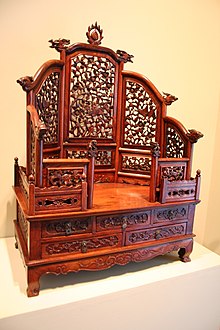Dalbergia odorifera
| Dalbergia odorifera | |
|---|---|
| Scientific classification | |
| Kingdom: | Plantae |
| Clade: | Tracheophytes |
| Clade: | Angiosperms |
| Clade: | Eudicots |
| Clade: | Rosids |
| Order: | Fabales |
| Family: | Fabaceae |
| Genus: | Dalbergia |
| Species: | D. odorifera
|
| Binomial name | |
| Dalbergia odorifera T. Chen
| |
| Synonyms[2] | |
| |
Dalbergia odorifera, or fragrant rosewood, Chinese rosewood[3] (Chinese: 降香黄檀; pinyin: jiàngxiāng huángtán; lit. 'drooping fragrant dalbergia'), is a species of legume in the family Fabaceae. It is a small or medium-sized tree, 10–15 metres (33–49 ft) tall.[4] It is endemic to China and occurs in Fujian, Hainan, Zhejiang,[4] and Guangdong.[5]

It is used as a wood product and in folk medicine.[3] This valuable wood is known in China as huali (花梨) or huanghuali (黄花梨).[5] Higher quality furniture from the late Ming and early Qing dynasties were made of this wood.[5]
Four compounds isolated from the root of this plant have been shown in a laboratory to have antioxidant properties.[6]
A deciduous tree, D. odorifera will start shredding leaves at around December of each year in the Northern Hemisphere. It becomes dormant throughout the winter months; towards the end of the winter or the beginning of spring right before the bud begin to swell, is probably the best time to prune the tree in shape.[citation needed]
It is threatened by overexploitation.[1]
References[]
- ^ Jump up to: a b World Conservation Monitoring Centre (1998). "Dalbergia odorifera". IUCN Red List of Threatened Species. 1998: e.T32398A9698077. doi:10.2305/IUCN.UK.1998.RLTS.T32398A9698077.en.
- ^ "The Plant List: A Working List of All Plant Species". Retrieved 11 December 2015.
- ^ Jump up to: a b "Dalbergia odorifera". Germplasm Resources Information Network (GRIN). Agricultural Research Service (ARS), United States Department of Agriculture (USDA). Retrieved 21 January 2018.
- ^ Jump up to: a b Dezhao Chen; Dianxiang Zhang & Kai Larsen. "Dalbergia odorifera". Flora of China. Missouri Botanical Garden, St. Louis, MO & Harvard University Herbaria, Cambridge, MA. Retrieved 18 May 2012.
- ^ Jump up to: a b c "The best Chinese furniture woods" (PDF). eastcornercompany.com. Archived from the original (PDF) on 2016-03-03. Retrieved 2011-08-09.
- ^ Yu, X.; Wang, W.; Yang, M. (2007). "Antioxidant activities of compounds isolated from Dalbergia odorifera T. Chen and their inhibition effects on the decrease of glutathione level of rat lens induced by UV irradiation". Food Chemistry. 104 (2): 715–720. doi:10.1016/j.foodchem.2006.10.081.
- IUCN Red List vulnerable species
- Dalbergia
- Endemic flora of China
- Trees of China
- Vulnerable plants
